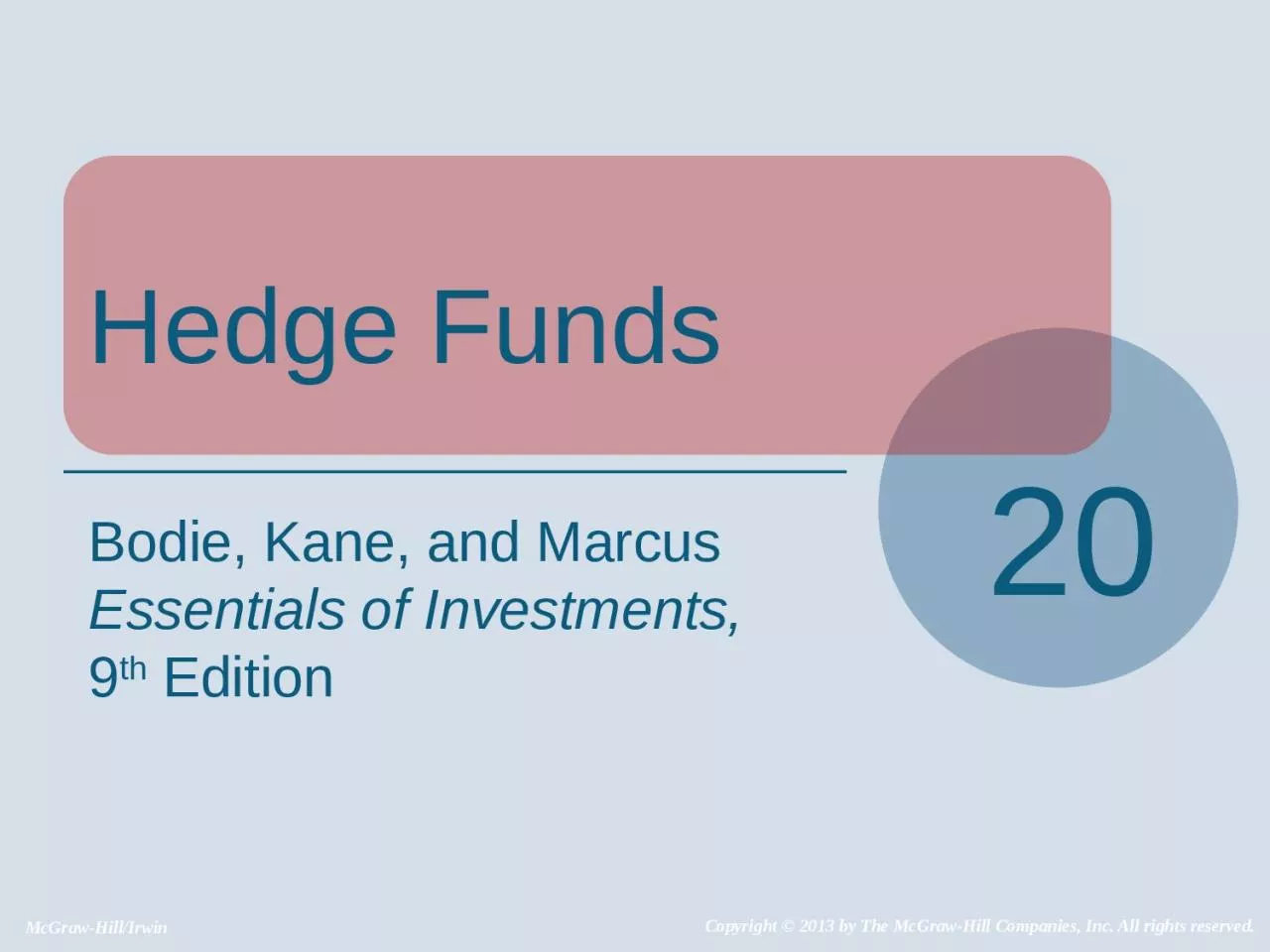

Essentials of Investments 9 th Edition 201 Hedge Funds versus Mutual Funds Mutual Funds Hedge Funds Transparency Public info on portfolio composition Info provided only to investors Investors ID: 1027782
Download Presentation The PPT/PDF document "Hedge Funds 20 Bodie, Kane, and Marcus" is the property of its rightful owner. Permission is granted to download and print the materials on this web site for personal, non-commercial use only, and to display it on your personal computer provided you do not modify the materials and that you retain all copyright notices contained in the materials. By downloading content from our website, you accept the terms of this agreement.
1. Hedge Funds20Bodie, Kane, and MarcusEssentials of Investments, 9th Edition
2.
3. 20.1 Hedge Funds versus Mutual FundsMutual FundsHedge FundsTransparencyPublic info on portfolio compositionInfo provided only to investorsInvestorsUnlimited< 100, high dollar minimumsStrategiesMust adhere to prospectus, limited short selling & leverage, limited derivatives usageNo limitations
4. 20.1 Hedge Funds versus Mutual FundsMutual FundsHedge FundsLiquidityRedeem shares on demandMultiple year lock-up periods typicalFeesFixed percentage of assets; typically .5% to 2%Fixed percentage of assets; typically 1% to 2% plus incentive fee = 20% of gains above threshold return
5. 20.2 Hedge Fund StrategiesDirectional and Nondirectional StrategiesDirectional strategySpeculation that one market sector will outperform othersNondirectional strategyDesigned to exploit temporary misalignments in relative pricing; typically involves long position in one security hedged with short position in related security
6. 20.2 Hedge Fund StrategiesDirectional and Nondirectional StrategiesMarket neutralDesigned to exploit relative mispricing within market; hedged to avoid taking stance on direction on broad marketPure playsBets on particular mispricing across two or more securities; extraneous sources of risk hedged away
7. Table 20.1 Hedge Fund Styles
8. 20.2 Hedge Fund StrategiesStatistical ArbitrageUse of quantitative system to uncover perceived misalignments in relative pricing and ensure profit by averaging over these betsPairs tradingPairing of stocks based on similarities; long-short positions established to exploit mispricing between eachData miningSorting through large amounts of historical data to uncover patterns to exploit
9.
10.
11.
12. 20.3 Portable AlphaAlpha TransferInvest in positive-alpha positions, hedge systematic risk of investment, and establish market exposure where desired using passive indexes
13. 20.3 Portable AlphaPure Play ExampleFind a portfolio with P > 0, but rM < 0We wish to hedge by selling stock-index futures. How many contracts should we sell if we have a $1,500,000 portfolio?β = 1.20 α = .02 rf = .01S&P 500 Index = 1,200 Futures multiplier = 250
14. 20.3 Portable AlphaPure Play ExampleFutures position value = 6 × 250 × (F0 − F1)F0 = 1.01S0 from spot futures parity modelF1 = S1 because of convergence of spot and futures prices at contract maturity, substituting into the future’s position value formula:6 x 250 × (1.01S0 – S1)S1 = S0(1 + rM); The market moves by rM so we now have:6 x 250 × (1.01S0 – S0(1 + rM)) 1,500 × (800(.01 – rM)) = $18,000 – $1,800,000rM
15. 20.3 Portable AlphaPure Play ExampleSpot futures position combined = 1,500 × (S0(.01 – rM))recall S0 = 1,200 so
16. Figure 20.1 Pure Play
17.
18.
19. 20.4 Style Analysis for Hedge Funds Style and Factor LoadingsMany fund strategies are directional bets and may be evaluated with style analysisDirectional investments will have nonzero betas called “factor loadings” Typical factors include exposure to stock markets, interest rates, credit conditions, and foreign exchange
20.
21. 20.5 Performance Management for Hedge FundsLiquidity and Hedge Fund PerformancePrices in illiquid markets tend to exhibit serial correlationFunds estimate values of investments to calculate fund’s share values and rates of returnFunds estimate prices optimistically Funds mark to market slowly instead of all at onceSerial correlation strongly related to fund’s Sharpe ratios; higher Sharpe ratios are compensation for illiquidity
22. 20.5 Performance Management for Hedge FundsFund Performance and Survivorship BiasBackfill biasInduced by including past returns on funds that entered sample because they were successfulSurvivorship biasInduced by excluding past returns on funds removed from sample because they were unsuccessful
23. 20.5 Performance Management for Hedge FundsFund Performance and Factor LoadingsMany performance measures assume constant risk levels; many hedge funds have variable risk levelsImplies positive alphas may be measurement errorMany funds hold options or perform like optionsOptions result in nonlinear performance, but most performance measures assume or fit straight line to return data
24. 20.5 Performance Management for Hedge FundsTail Events and PerformanceMany hedge funds employ mathematical models that rely on near-term historical price data Strategies’ performance in form of a written put optionWay to capture the put premium, appropriate in low-volatility markets Face large losses in high-volatility markets: Out of pocket if markets fall, large opportunity costs if markets riseWhen tail events occur, hedge fund performance may suffer large losses
25. Figure 20.2 Average Hedge Fund Returns as Function of Liquidity Risk
26. Table 20.3 Index Model Regressions for Hedge Fund Indexes
27. Figure 20.3A Hedge Funds with Higher Serial Correlation in Returns
28. Figure 20.3B Hedge Funds with Higher Serial Correlation in Returns
29. Figure 20.4 Characteristic Line of Perfect Market Timer
30. Figure 20.5 Characteristic Line of Stock Portfolio with Written Options
31. Figure 20.6A Monthly Returns on Hedge Fund Indexes versus Return on S&P 500, 1/2005-11/2011
32. Figure 20.6B Monthly Returns on Hedge Fund Indexes versus Return on S&P 500, 1/2005-11/2011
33. Figure 20.6C Monthly Returns on Hedge Fund Indexes versus Return on S&P 500, 1/2005-11/2011
34.
35. 20.6 Fee Structure in Hedge FundsIncentive FeeEqual to share of any investment returns beyond stipulated benchmark performanceHigh Water MarkPrevious portfolio value; must be reattained before hedge fund can charge incentive feesFund of FundsHedge funds investing in other hedge funds
36. Figure 20.7 Incentive Fees as Call Option
37.
38.